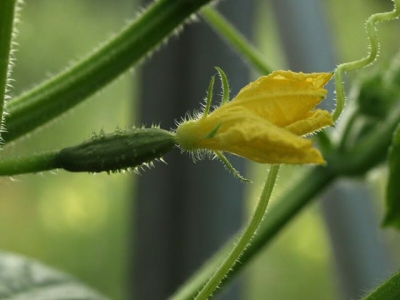The Secret To Wildly Increasing Cucumber Yields

As anyone who’s tried to grow a member of the cucurbit family (which includes melons, squashes and cucumbers) knows, getting fruits from these plants doesn’t always happen all on its own. Unlike tomato and pepper blossoms, cucumber flowers don’t all become fruits. Instead, the male flowers have to pollinate the female flowers.
Images (top to bottom) via Flickr users veganbaking
A new study, led by Zhangjun Fei of the Boyce Thompson Institute at Cornell University and Sanwen Huang of the Chinese Academy of Agricultural Sciences in Beijing, has identified the DNA that’s responsible for turning a cucumber plant from a normal plant to a high-producing all-female plant. This is a huge step.
Cucumbers are naturally monoecious, meaning their flowers can be one of multiple sexes, and for the female flower to produce a fruit, it needs to be fertilized by a male flower. This would normally happen in the wild thanks to insects like bees, but can also be done manually by humans (a typical technique involves a very fine paintbrush and a whole lot of patience). In a commercial setting, though, that’s a liability.
Male flowers can pollinate multiple female flowers, meaning each individual male flower is much less valuable and thus of less interest to growers. Ideally, a cucumber farmer has a minimum number of male flowers and as many female flowers as possible.
All-female cucumber varieties were a sensation when they appeared in the late 1960s, according to the Foods and Food Production Encyclopedia. Many big growers have found them profitable for commercial operations, and amateur gardeners, now able to buy all-female cucumber seeds, find them easy to grow in the home garden. But until now, no one had discovered the gene responsible for them, and all-female cukes were created either by extreme inbreeding or by dosing with brassinosteroids, a naturally produced but artificially applied type of plant hormone. Finding the specific gene responsible for deciding the sex of flowers may open up new ways of creating higher yielding all-female cucumbers.
The new study sequences the genes of 115 different cucumber family lines.. This builds on non-genomic work done by farmers: we already knew it was possible to get all or mostly female flowers, but the process for getting there was extremely inefficient. The new information could help farmers ramp up their production without the trouble of selectively breeding for generations just a few genetic modifications, and you’ve got a cucumber that produces many, many more fruits than before.
And just in time for cucumber season.
Related news
 10 Edible Weeds Likely Growing in Your Yard
10 Edible Weeds Likely Growing in Your Yard You work so hard on your vegetable garden, primping and pruning to the point of exhaustion each spring. One of the biggest chores, of course, is weeding
 Soil pH – the cure for clubroot in cabbages
Soil pH – the cure for clubroot in cabbages Clubroot really is a revolting disease -that’s literally the reaction of any farmer who pulls out a sickly-looking plant and sees what the root system
 Blight can make a bean crop worthless
Blight can make a bean crop worthless Last week I mentioned that halo blight thrives in cooler conditions and spreads very rapidly in wet ones.